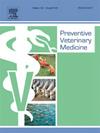Truck cleaning and disinfection, and the risk of PRRSV dissemination in multi-site pig production systems in the United States: A network-epidemiological model approach
IF 2.2
2区 农林科学
Q1 VETERINARY SCIENCES
引用次数: 0
Abstract
Porcine reproductive and respiratory syndrome virus (PRRSV) poses a significant threat to pig health, particularly in multi-site industrial pig farming systems. These systems, which involve raising pigs at different locations based on their age and transporting them via trucks and trailers, may increase the risk of pathogen transmission through contaminated vehicles. Given the importance of preventing PRRSV infection, vehicle cleaning and disinfection (C&D) are crucial for disease control. This study examined data from four PRRSV outbreaks in U.S. sow farms during a regional emergence of a PRRSV2 variant in multi-site swine production systems, focusing on vehicle movements before and after the outbreaks and their C&D frequencies. This research analysed 1190 vehicle movement records between premises and 753 visits to truck wash stations, creating networks encompassing seven vehicles across 45 sites, including breeding, growing, and isolation facilities. Network simulations were used to evaluate the infection sources and virus transmission risks under various vehicle C&D frequencies during outbreaks. Results showed no significant changes in movement frequency before and after the outbreak. The infection risk varied by farm type and specific connections to the outbreak farm, with higher risks observed in growing farms. Scenario comparisons to assess the impact of C&D frequencies on transmission showed that adherence to vehicle C&D protocols resulted in infection risks nearly matching optimal scenarios. The most substantial differences were observed when comparing infection probabilities in the pessimistic scenario to those in the realistic scenario, with probabilities being significantly higher in the pessimistic scenario, particularly for gilt isolation farms (7.6 % higher) and sow farms (6.6 % higher). These findings underscore the critical role of thorough cleaning and disinfection protocols in reducing infection risk.This research assesses the risks of infection introduction and spread during outbreaks, emphasising the critical role of truck washing in controlling PRRSV. The study provides quantitative evidence that consistent vehicle C&D practices significantly reduce transmission risks, offering valuable insights into disease transmission pathways. These findings inform targeted interventions to enhance biosecurity and strengthen disease prevention strategies.
卡车清洁和消毒,以及PRRSV在美国多点生猪生产系统中的传播风险:网络流行病学模型方法
猪繁殖与呼吸综合征病毒(PRRSV)对猪的健康构成重大威胁,特别是在多地点工业化养猪系统中。这些系统涉及根据猪龄在不同地点养猪,并通过卡车和拖车运输,可能会增加病原体通过受污染车辆传播的风险。鉴于预防PRRSV感染的重要性,车辆清洁和消毒(C&;D)对疾病控制至关重要。本研究检查了美国母猪场在多地点生猪生产系统中出现PRRSV2变体期间发生的四次PRRSV爆发的数据,重点关注爆发前后的车辆移动及其C&;D频率。这项研究分析了1190辆汽车在经营场所之间的移动记录和753次洗车站的访问,创建了一个由45个地点的7辆汽车组成的网络,包括繁殖、生长和隔离设施。采用网络模拟方法,评估了疫情期间不同车辆感染频率下的传染源和病毒传播风险。结果显示,疫情前后运动频率无明显变化。感染风险因农场类型和与爆发农场的具体联系而异,在种植农场观察到更高的风险。评估C&;D频率对传播影响的情景比较表明,遵守车辆C&;D方案导致感染风险接近最佳情景。在比较悲观情景和现实情景的感染概率时,观察到最显著的差异,悲观情景的感染概率明显更高,特别是母猪隔离场(高7.6% %)和母猪场(高6.6% %)。这些发现强调了彻底清洁和消毒方案在降低感染风险方面的关键作用。这项研究评估了疫情期间感染引入和传播的风险,强调了卡车清洗在控制PRRSV中的关键作用。该研究提供了定量证据,表明一致的车辆C&;D实践显著降低了传播风险,为疾病传播途径提供了有价值的见解。这些发现为有针对性的干预措施提供了信息,以加强生物安全和加强疾病预防战略。
本文章由计算机程序翻译,如有差异,请以英文原文为准。
求助全文
约1分钟内获得全文
求助全文
来源期刊

Preventive veterinary medicine
农林科学-兽医学
CiteScore
5.60
自引率
7.70%
发文量
184
审稿时长
3 months
期刊介绍:
Preventive Veterinary Medicine is one of the leading international resources for scientific reports on animal health programs and preventive veterinary medicine. The journal follows the guidelines for standardizing and strengthening the reporting of biomedical research which are available from the CONSORT, MOOSE, PRISMA, REFLECT, STARD, and STROBE statements. The journal focuses on:
Epidemiology of health events relevant to domestic and wild animals;
Economic impacts of epidemic and endemic animal and zoonotic diseases;
Latest methods and approaches in veterinary epidemiology;
Disease and infection control or eradication measures;
The "One Health" concept and the relationships between veterinary medicine, human health, animal-production systems, and the environment;
Development of new techniques in surveillance systems and diagnosis;
Evaluation and control of diseases in animal populations.
 求助内容:
求助内容: 应助结果提醒方式:
应助结果提醒方式:


